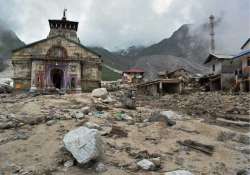A year after tragedy, Uttarakhand people remember a braveheart
Gopeshwar: It is a little over a year since a natural calamity of catastrophic proportions hit Uttarakhand but people in the affected areas are still singing paeans to the bravery of Darshan Lal who saved

Gopeshwar: It is a little over a year since a natural calamity of catastrophic proportions hit Uttarakhand but people in the affected areas are still singing paeans to the bravery of Darshan Lal who saved hundreds of lives in Kedar valley when the deluge struck.
They have still not forgotten what this humble braveheart did for them out of the sheer urge to save the lives of fellow human beings on that fateful day despite being untrained in disaster management and without possessing any life saving equipment.
Darshan Lal jumped to the rescue of hundreds of devotees and locals stranded between Songanga and Mandakini, villagers recounted.
Resident of Toshi village Indra Singh, who lost six of his family members in the tragedy gets emotional while talking about Lal's act of valour.
Battling the pangs of the death of his dear ones and the ferocity of a downpour, Indra had arrived on the banks of Songanga on the afternoon of June 17 after losing two of his sons and four other relatives at Rambara a day earlier.
There were hundreds of others like him among the pilgrims as well as the locals who had followed him to the banks of the Songanga.
“Hundreds of us were stuck at a point where the rocks overhead were sliding and the ones beneath were being eroded by the swirling waters of a furious river. The bridge through which we could have crossed over to the other side had already been washed away.
Sonprayag town was visible in the front but our cries for help were buried in the noisy flow of the waters of Songanga and Mandakini which were in spate and the falling downpour. We were clueless about what was going to happen to us,” recounts Indra.
“We survived yet another cold and wet night in close proximity to imminent death. On the morning of June 18 Darshan Lal came almost like an angel. He made a long rope of broken electric wires, tied one end of it to the trunk of a fallen tree and the other around his waist and waded into water.
“As he was approaching us he faltered many a time amid the strong currents but continued wading through it until he reached a small island in the middle. Lal took four hours to make a makeshift bridge out of a huge broken tree trunk swept to the island by the flashfloods by pushing and placing it with the help of some of the stranded people between the two banks of the river.
“From the morning of June 18 to four o clock that evening Lal helped hundreds of us cross over to Sonprayag through that makeshift bridge and ferried the old and the children on his shoulders to the other side,” says Indra as his voice chokes.
They have still not forgotten what this humble braveheart did for them out of the sheer urge to save the lives of fellow human beings on that fateful day despite being untrained in disaster management and without possessing any life saving equipment.
Darshan Lal jumped to the rescue of hundreds of devotees and locals stranded between Songanga and Mandakini, villagers recounted.
Resident of Toshi village Indra Singh, who lost six of his family members in the tragedy gets emotional while talking about Lal's act of valour.
Battling the pangs of the death of his dear ones and the ferocity of a downpour, Indra had arrived on the banks of Songanga on the afternoon of June 17 after losing two of his sons and four other relatives at Rambara a day earlier.
There were hundreds of others like him among the pilgrims as well as the locals who had followed him to the banks of the Songanga.
“Hundreds of us were stuck at a point where the rocks overhead were sliding and the ones beneath were being eroded by the swirling waters of a furious river. The bridge through which we could have crossed over to the other side had already been washed away.
Sonprayag town was visible in the front but our cries for help were buried in the noisy flow of the waters of Songanga and Mandakini which were in spate and the falling downpour. We were clueless about what was going to happen to us,” recounts Indra.
“We survived yet another cold and wet night in close proximity to imminent death. On the morning of June 18 Darshan Lal came almost like an angel. He made a long rope of broken electric wires, tied one end of it to the trunk of a fallen tree and the other around his waist and waded into water.
“As he was approaching us he faltered many a time amid the strong currents but continued wading through it until he reached a small island in the middle. Lal took four hours to make a makeshift bridge out of a huge broken tree trunk swept to the island by the flashfloods by pushing and placing it with the help of some of the stranded people between the two banks of the river.
“From the morning of June 18 to four o clock that evening Lal helped hundreds of us cross over to Sonprayag through that makeshift bridge and ferried the old and the children on his shoulders to the other side,” says Indra as his voice chokes.